 |
 |
 |
| |
Boceprevir Plus Peginterferon alfa-2b/Ribavirin for Treatment of Genotype 1 Chronic Hepatitis C in Previously Untreated Patients: Interim Results from the HCV SPRINT-1 Study
|
| |
| |
Reported by Jules Levin
AASLD Nov 3 2008 San Francisco, CA
P. Kwo,1 E. Lawitz,2 J. McCone,3 E. Schiff,4 J. Vierling,5 D. Pound,6 M. Davis,7 J. Galati,8 S. Gordon,9 N. Ravendhran,10 L. Rossaro,11 F. Anderson,12 I. Jacobson,13 R. Rubin,14 K. Koury,15 E. Chaudhri,15 J. Albrecht15
1Indiana University School of Medicine, Indianapolis, IN; 2Alamo Medical Research, San Antonio, TX; 3Mount Vernon Endoscopy Center, Alexandria, VA; 4University of Miami Center for Liver Diseases, Miami, FL; 5Baylor College of Medicine, Houston, TX; 6Indianapolis Gastroenterology Research Foundation, Indianapolis, IN; 7South Florida Center of Gastroenterology, Wellington, FL; 8Liver Specialists of Texas, Houston, TX; 9Henry Ford Hospital, Detroit, MI; 10Digestive Disease Associates, Baltimore, MD; 11University of California-Davis, Sacramento, CA; 12The Liver & Intestinal Research Center, Vancouver, Canada; 13Weill Medical College of Cornell University, New York, NY; 14Digestive Healthcare of Georgia, Atlanta, GA; 15Schering-Plough Research Institute, Kenilworth, NJ
AUTHOR SUMMARY
In this study, boceprevir when combined with P/R is safe for use up to 48 weeks
Boceprevir substantially improves SVR rates with 28 weeks of therapy and nearly doubles the SVR compared to the current P/R SOC for 48 weeks
Use of a 4-week lead-in with P/R prior to the addition of boceprevir appears to reduce the incidence of viral breakthrough regardless of treatment duration and may improve SVR over a 48-week treatment duration
Further follow-up of this cohort and a large phase 3 trial examining the role of boceprevir will help define the optimal treatment paradigm for the incorporation of boceprevir to P/R in the treatment of genotype 1 HCV infected individuals
ABSTRACT
Background: Boceprevir (Boc) is an oral HCV-NS3 protease inhibitor being
assessed in combination with peginterferon alfa-2b (P) 1.5 mg/kg/QW and
ribavirin (R) for chronic hepatitis C.
Methods: HCV SPRINT-1 is a Phase 2 study in HCV-1 patients evaluating Boc
800 mg TID in three treatment regimens: 1) 4 weeks of P/R 800-1400 mg/d
(lead-in) followed by addition of Boc to the combination for 24 or 44 weeks (total
28 or 48 weeks); 2) Boc in combination with P/R (800-1400 mg/d) for 28 or 48
weeks; 3) Boc in combination with P/low-dose R (400-1000 mg/d) for 48 weeks,
compared to P (1.5 mg/kg QW)/R (800-1400 mg/d) for 48 weeks. The primary
endpoint of the study is sustained virologic response (SVR) at 24 weeks of
follow-up (Roche Cobas Taqman: LLD 15 IU/mL).
Results: 595 patients treated: 77% US, 16% Black, 7% cirrhotic, 89% >600,000
IU/mL. Regimens 1, 2 and P/R control results from a planned interim analysis are
reported. Addition of Boc markedly increased SVR with 28 and 48 week regimens compared to P/R control. SVR was higher with a 4-week P/R lead-in for the 48 week regimen, while a decrease in viral breakthrough was observed with both 28 and 48-week lead-in regimens. As with P/R, rapid virologic response (RVR) and early virologic response (EVR) were highly predictive of response with the Boc combinations. The most common adverse events reported in the Boc arms were fatigue, anemia, nausea and headache. Incidence of rash-related AEs was similar in boceprevir-containing regimens and P/R control. Treatment discontinuations due to adverse events were between 9 to 19% for patients in Boc arms, compared to 8% in control arm.
Conclusions: In this study, boceprevir when combined with P/R is safe for use up to 48 weeks and substantially improves SVR rates with 28 weeks of therapy and can nearly double the SVR compared to the current P/R standard of care (48 weeks) in this trial. Use of a 4-week lead-in with P/R prior to the addition of boceprevir appears to reduce the incidence of viral breakthrough.
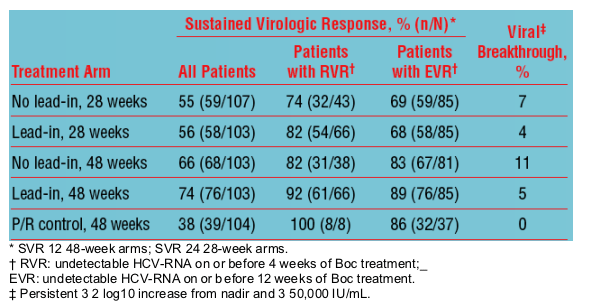
BACKGROUND
Combination therapy with pegylated interferon-alfa and weight-based ribavirin is the standard of care (SOC) for the treatment of chronic hepatitis C (CHC) patients infected with HCV genotype 1
-- However, only approximately 40%1,2 of these patients achieve sustained virologic response (SVR) with SOC
Boceprevir inhibits the HCV-NS3 protease, thereby preventing viral replication
-- A new mechanism of action compared with both pegylated interferon-alfa and
Boceprevir may improve virologic response and shorten treatment duration when added to the current SOC regimen
Previous studies with SOC have shown that patients who achieve rapid virologic response (RVR) and early virologic response (EVR), defined as undetectable HCV-RNA in plasma at Week 4 and Week 12 of treatment, respectively, are more likely to attain SVR
The addition of boceprevir to SOC may lead to a greater proportion of subjects achieving RVR and EVR
Four weeks of PegIntron and ribavirin lead-in treatment should allow
-- Achievement of steady-state drug levels
-- Alpha interferon-mediated immune system activation
-- Lower HCV burden
This lead-in strategy may reduce the emergence of viral resistance by decreasing the pool of pre-existing viral quasi-species
AIMS
Evaluate the safety and efficacy of boceprevir in combination with PegIntron 1.5 mg/kg plus ribavirin in previously untreated adults with genotype 1 CHC
Assess the relationship between RVR and EVR to SVR
Assess the effect of the 4-week lead-in with PegIntron and ribavirin on SVR
Assess the effect of duration of treatment with boceprevir on SVR
METHODS
This is an open-label randomized trial conducted in two parts
Part 1 has 5 treatment arms, randomized 1:1:1:1:1, and compares
-- PegIntron and ribavirin for 4 weeks followed by PegIntron, ribavirin, and
boceprevir for 44 weeks (Arm 5)
-- PegIntron, ribavirin, and boceprevir for 48 weeks (Arm 4)
-- PegIntron and ribavirin for 4 weeks followed by PegIntron, ribavirin, and
boceprevir for 24 weeks (Arm 3)
-- PegIntron, ribavirin, and boceprevir for 28 weeks (Arm 2)
-- PegIntron and ribavirin for 48 weeks (Control Arm 1)
Note: Ribavirin dosing for Part 1 is weight based, 800 to 1400 mg/d
Part 2 enrolled after Part 1 and has 2 treatment arms randomized 1:4 and
compares
-- PegIntron, ribavirin (800 to 1400 mg/d), and boceprevir for 48 weeks (Arm 6)
-- PegIntron, ribavirin (400 to 1000 mg/d), and boceprevir for 48 weeks (Arm 7)
Note: Data for Part 2 not available at the time of this interim analysis
Patients at baseline
-- CHC genotype 1; treatment na´ve; liver biopsy (all histologic grades including
cirrhosis), aged 18-60 years, 45-125 kg
Efficacy assessments
-- Proportion of patients with undetectable HCV-RNA using Roche COBAS TaqMan LLD 15 IU/mL
-- SVR 12 for 48-week arms
-- SVR 24 for 28-week arms
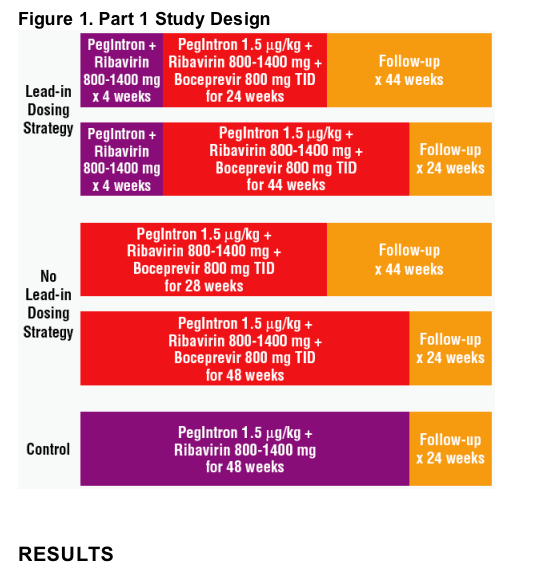
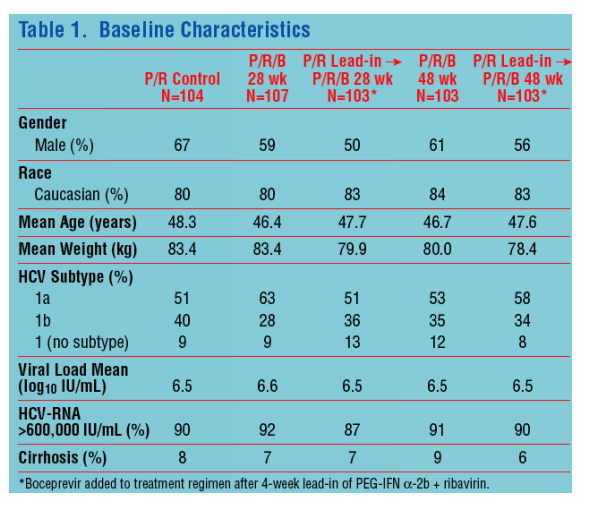
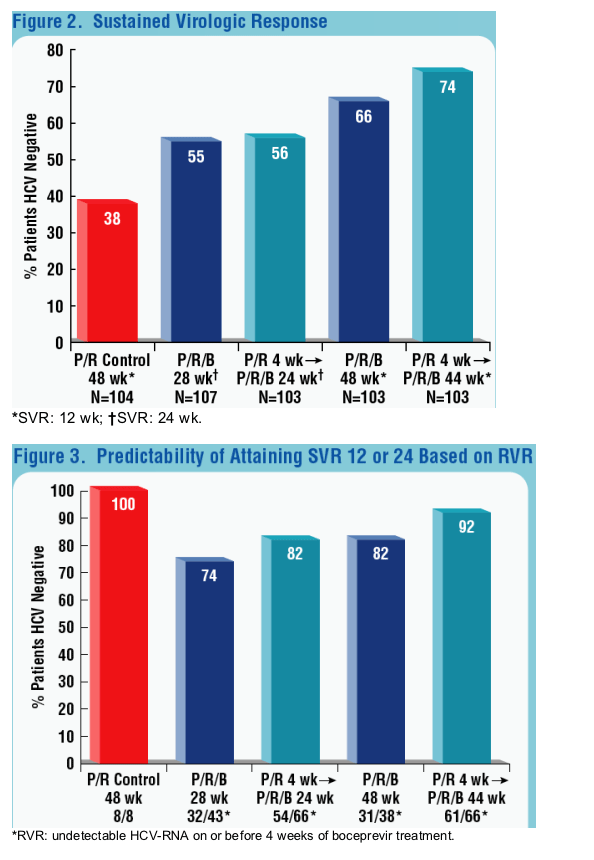
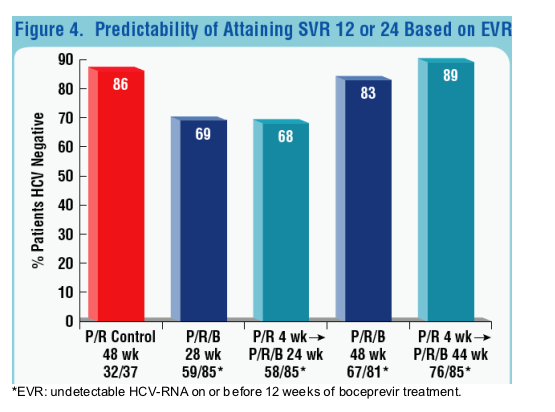
The addition of boceprevir markedly increased SVR with 28- and 48-week regimens compared with P/R control
SVR was higher with a 4-week P/R lead-in for the 48-week regimen
RVR and EVR in boceprevir-containing arms very predictive of SVR
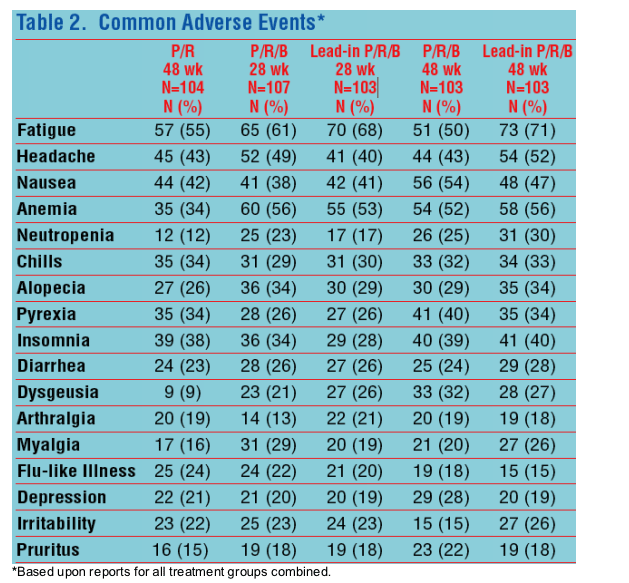
Common adverse events (AEs) in boceprevir-containing arms
-- Mostly constitutional symptoms
-- Comparable to P/R control
Pruritus comparable to P/R control
Higher incidence of dysgeusia and anemia in boceprevir-containing arms
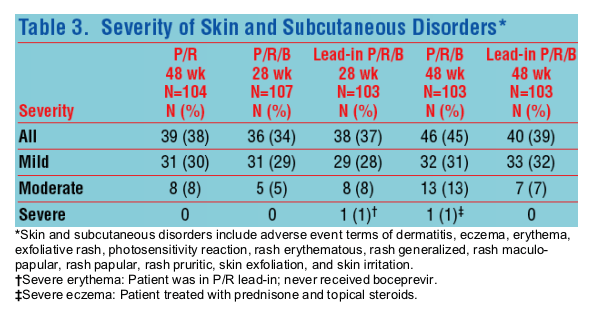
Incidence of rash-related AEs was similar in boceprevir-containing regimens and P/R control
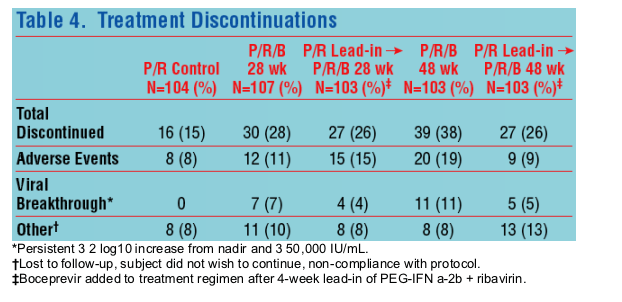
Treatment discontinuations due to AEs were between 9 to 19% in
boceprevircontaining arms
Less viral breakthrough in lead-in arms
REFERENCES
1. Fried M, et al. N Engl J Med. 2002;347:975-82.
2. Manns M, et al. Lancet. 2001;358:958-65.
|
| |
|
 |
 |
|
|